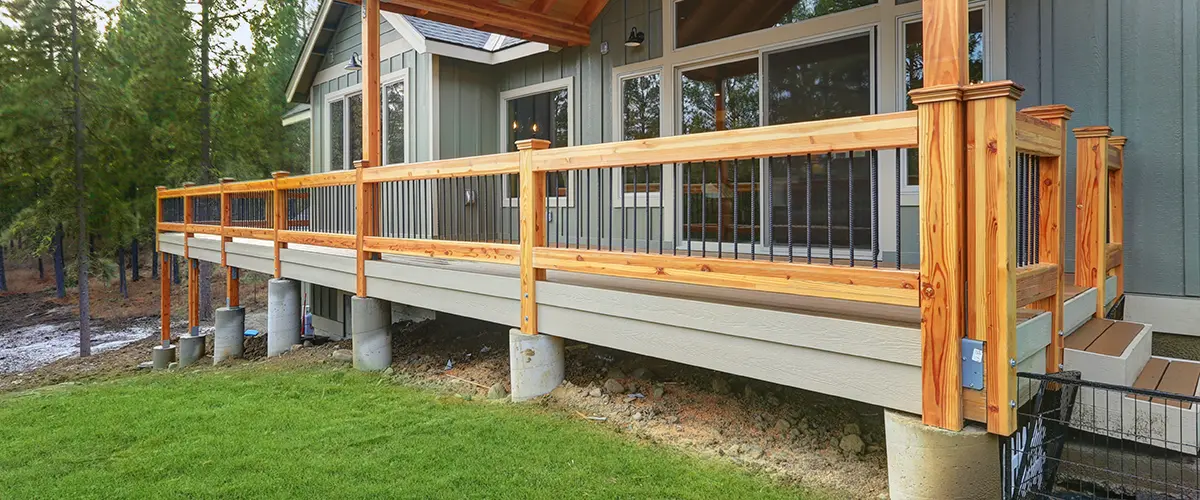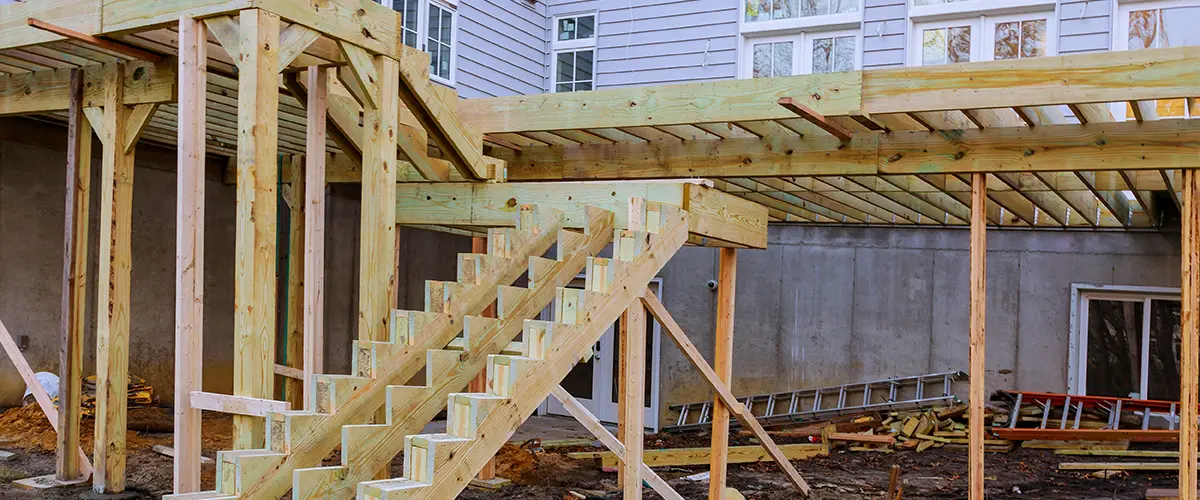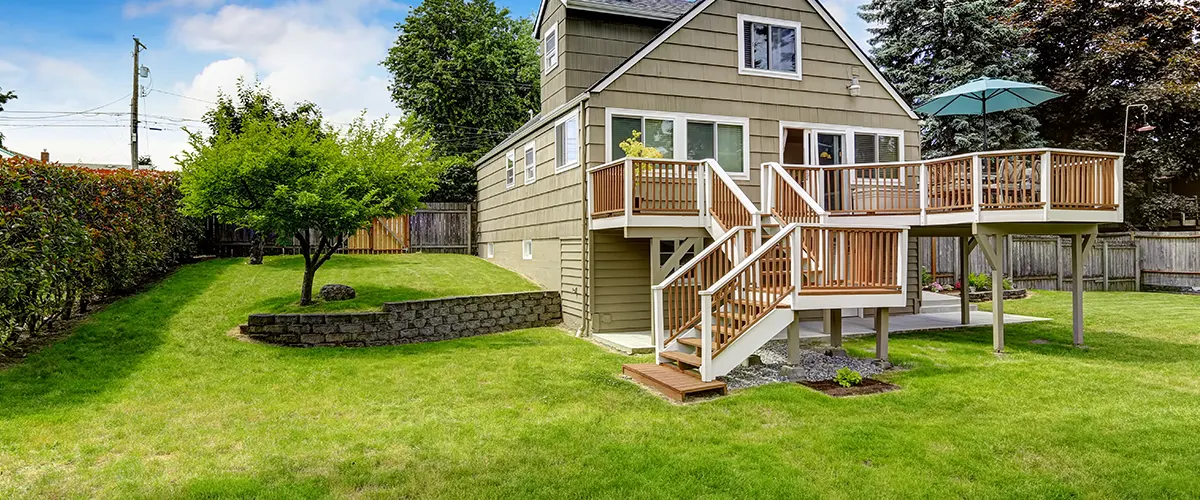Building a deck is a fantastic way to extend your living space outdoors and create a relaxing and entertaining area for family and friends.
When constructing a deck, one crucial aspect that demands attention is the selection of deck posts and the materials used for them.
In this blog post, we will delve into what deck posts are, their usage, and explore the top deck post materials in 2023.

What are Deck Posts and How to Use Them
Deck posts are vertical support structures that bear the weight of the deck and transfer it to the footings or foundation below.
These sturdy pillars are the backbone of any deck, ensuring its stability and structural integrity.
Deck posts are typically placed at regular intervals along the perimeter of the deck, and their proper installation is vital to ensure the safety and longevity of the structure.
How To Properly Use Deck Posts
- Planning and Design: Determine the layout and size of your deck, considering factors like the intended use, local building codes, and the load-bearing capacity required. Adequate planning is essential to ensure the deck posts are placed optimally.
- Material Selection: Choose a high-quality material for your deck posts that suits your style, budget, and climate conditions. We will explore the top deck post materials for 2023 later in this article.
- Installation: Precisely measure and mark the locations where the deck posts will be installed. Dig appropriate footings or use post anchors to secure the posts firmly into the ground. Ensure that the posts are level and plumb during installation.
- Connection to Beams and Joists: Connect the deck posts to the horizontal beams and joists using appropriate hardware, such as joist hangers and post caps. This ensures a secure and stable connection between different elements of the deck.
- Regular Maintenance: Inspect and maintain the deck posts regularly to check for any signs of wear, rot, or damage. Promptly address any issues to prevent structural problems and extend the life of your deck.

Note: It’s always best to leave deck posts installation to the professionals. Let our deck installation expertise come to aid you and provide you and your family with a secure, long-lasting deck structure.
Top 5 Deck Posts Materials in 2023
The choice of deck post material greatly impacts the aesthetics, durability, and maintenance requirements of your deck. Here are the top deck post materials trending in 2023:
- Pressure-Treated Wood: A perennial favorite, pressure-treated wood is affordable and offers decent resistance against decay and insects. It is chemically treated to enhance its durability, making it suitable for deck posts. Regular maintenance, such as staining and sealing, can prolong its lifespan.
- Cedar: Cedar is a natural, beautiful wood that resists decay and insect infestation. It has a distinct fragrance and rich color that adds a touch of elegance to any deck. Cedar deck posts are relatively durable, but they may require periodic sealing to maintain their appearance.
- Composite: Composite deck posts are a blend of wood fibers and recycled plastic. They are highly resistant to rot, insects, and weathering, making them a low-maintenance option. Composite materials come in various colors and styles, offering versatility for design.
- Steel: Steel deck posts provide exceptional strength and stability. They are less susceptible to warping, rot, or insect damage, making them a long-lasting choice. Steel posts can be used for contemporary and industrial-style decks and require little maintenance.
- Aluminum: Aluminum deck posts are lightweight, corrosion-resistant, and ideal for coastal or humid environments. They come in various powder-coated finishes, allowing customization to match the deck's aesthetics.
Bonus: Trex Transcend is a high-performance composite decking brand that offers railing posts with a sleek and modern appearance. These posts are durable, low-maintenance, and available in various colors.
Let’s dive deeper into each of these materials and learn their advantages and drawbacks.
Pressure-Treated Wood
| Pros | Cons |
|---|---|
| Pressure-treated wood is widely available and relatively inexpensive compared to other materials. | To prevent weathering and decay, pressure-treated wood requires regular maintenance, including staining and sealing. |
| It is easy to cut, shape, and install, making it a popular choice for DIY deck projects. | Over time, pressure-treated wood may warp, split, or crack, especially if not properly maintained. |
| The treatment process improves its resistance against decay and insects. | While treated, it may still be susceptible to insect damage in certain conditions. |
Cedar
| Pros | Cons |
|---|---|
| Cedar has an attractive appearance, adding a touch of elegance to any deck. | Cedar is generally more expensive than pressure-treated wood. |
| Cedar's natural oils and tannins provide excellent resistance to decay and insect damage. | Though not as frequent, cedar still requires some maintenance to preserve its appearance. |
| While not as demanding as pressure-treated wood, periodic sealing can help maintain its appearance. | Depending on the location, cedar may not be as readily available as pressure-treated wood. |

Composite
| Pros | Cons |
|---|---|
| Composite posts do not require staining, sealing, or painting, saving time and effort on upkeep. | Composite materials generally have a higher upfront cost than wood options. |
| Composites are highly resistant to rot, insects, and weathering, making them long-lasting. | Some composite products may experience fading or discoloration over time, though many modern composites come with UV-resistant coatings. |
| Available in various colors and styles, composite posts allow for versatile deck designs. | While some composites are designed to mimic natural wood, they may have a different feel and appearance than traditional wood materials. |
Steel
| Pros | Cons |
|---|---|
| Steel deck posts provide exceptional strength and stability, making them ideal for heavy loads and robust deck designs. | If not properly coated or maintained, steel posts may be susceptible to rust over time, especially in humid or corrosive environments. |
| Unlike wood, steel is less susceptible to warping, splitting, or insect damage, ensuring a longer lifespan. | Steel is heavier than wood or composite, which can make handling and installation more challenging. |
| Steel posts offer a contemporary and industrial-style look, providing a unique touch to the overall deck design. | Steel deck posts may be more expensive than certain wood or composite options. |
Aluminum
| Pros | Cons |
|---|---|
| Aluminum is lightweight and easy to work with, simplifying the installation process. | Aluminum posts may be relatively more expensive than certain wood or composite options, though they offer long-lasting benefits. |
| Aluminum does not rust, making it an excellent choice for coastal or humid environments where moisture is a concern. | While aluminum posts come in various finishes, the color choices may not be as extensive as composite materials. |
| Aluminum requires minimal maintenance to keep its appearance intact, reducing upkeep efforts. | Aluminum posts may have a distinct appearance compared to natural wood or composite materials, which may not appeal to all design preferences. |
Deck Posts FAQs
Conclusion
Selecting the right deck posts and materials is critical to building a safe, stylish, and durable deck that enhances your outdoor living space.
By understanding the importance of deck posts, their proper usage, and the top deck post materials available in 2023, you can make an informed decision that suits your needs and preferences.
If you want to find out more about deck posts or other alternatives to your project, get in touch with us today at (865) 801-4545 or request a free quote!

